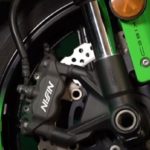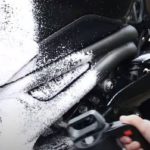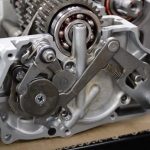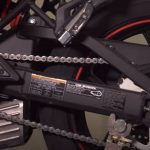Lots of sport bikes come with a steering damper from the factory, and for those that don’t, plenty of people add them as an accessory. But what does a steering damper do, and are they really worth it for your motorcycle?
If you hit a bump that deflects your front tire, or if you’re accelerating hard enough that you lift the front wheel, the front can whip back towards the center. That can set off a chain reaction that often ends very, very badly. Tank-Slapper are some of the most violent terrifying experiences in motorcycling, and they often end in a crash. This can be very dangerous for the rider and those around him.
How Does a Steering Damper Work?
Table of Contents
A steering damper, also called a steering stabilizer, is essentially suspension for your steering. Just as your fork and shock control your wheels’ vertical motion, a steering stabilizer controls the movement of your bike’s side-to-side motion.
It even uses the same technology, namely oil passing through a fixed hole, that restricting the flow creates the damping that controls how fast your front-end turns.
Types Of Motorcycle Damper Control
There are a bunch of different kinds of steering dampers out there, from radial ones that mount to the top of the triple clamp, to linear units that mount to the bottom or side of the triple clamp.
There are even electronically controlled stabilizers that vary the damping based on the bike speed. Regardless of the damper’s style or location, They all do the same thing, and that is slowed down your steering.

Do Steering Dampers Prevent Tank Slappers?
Most riders like a bike with light, easy steering, so why would you want to slow down how fast your front end turns?
What Is The Purpose of a Steering Damper on a Motorcycle?
Steering dampers help prevent and interrupt high-speed front-end oscillations, but for the most part, they don’t inhibit slow-speed steering.
That’s because the circuitry within the damper, which like a damper rod fork, is rate sensitive, or in the case of my ZX10, it’s electronically controlled.
If you’re turning the bar slowly, there’s not much resistance, but if you try and turn them quick, the resistance ramps up.
You mostly see steering dampers on 600 and 1000 cc sport bikes because they’re the machines that are most susceptible to wobbles and tank slappers.s
They’ve got lots of horsepowers, they’ve got short wheelbases, steep steering geometry, all of which makes a tank-slapper more likely.
Many off-road bikes run steering dampers too because those guys are ripping across uneven terrain that can deflect the front tire.
Cruisers don’t typically run steering dampers because the bike’s weight, wheelbase, and other factors mean they’re unnecessary.
So safety and stability are concerns for steering dampers, but so is a personal preference.
Some people just like dampers because they feel it makes the steering smoother or more controlled, or they see it as cheap insurance to keep their bike from freaking out at speed.
Style is a big factor too, and plenty of people will install a steering damper even if their bike or the riding style doesn’t warrant It.
Here’s a tip, though. If your bike has recently started handling oddly, don’t band-aid the problem with a steering damper.
A motorcycle traveling in a straight line is inherently stable, So if yours isn’t, you should be looking at your tire wear, your wheel alignment, and your head bearings.
Whatever the reason for running a steering damper, now you know what they do and why they exist.
Other Steering Issues
Pretty much any problem that arises with the way your motorcycle turns, tracks, or handles will be the result of something braking wearing out or wandering out of specification.
If something breaks, the change will be sudden, while other issues may be progressive and worsen over time.
The most common handling issue that people encounter is heavy high effort sluggish steering.
If you find that you have to muscle on the handlebar to get your motorcycle turn, you have to maintain bar pressure to get it to stay on a line; the first thing you should check is your tires.
A worn profile will cause this kind of handling, such as low tire pressure, or even if it’s just off by a couple of psi.
And if you have a steering damper, make sure you check the settings since your buddy or someone else might have cranked it up.
Also, if your steering head bearings are getting tight, or if they’re corroded and rusty. That will make the steering feel heavy, too, since it’s going to make it hard to turn the handlebars.
Another complaint we hear is about a bike that doesn’t want to track straight.
That might mean that it weaves down the road, or it might even pull to one side. If that’s the case, there are a few things you’ll want to check.
The first thing you want to verify is that your wheels are aligned, and if you have spoke wheels, make sure there aren’t any loose spooks.
Loose or worn steering head swing arm or wheel bearings could also be the culprit.
However, don’t confuse an actual instability issue with tram lighting, which is a common thing that occurs as your tires follow grooves in the road.
There’s nothing you can do about it except relax and let it happen, or you can take a different route.
If your bike is vibrating a lot more than it used to, someone might have swapped out your multi cylinder engine for a single, or more likely, a major bolt might have loosened up.
If that’s the case, you better put a torque wrench on the nuts and bolts that secure the engine to the frame.
On the other hand, if it feels like the vibrations coming from your wheels, you may have lost a wheel weight, your wheels may be out of true, or there might be something wrong with your tires.
It’s best to inspect your tires for things like a bulge and then spin your wheels to make sure they run true.
If your bike has gotten more sensitive to bumps and feels harsh, your suspension may be binding up.
This will happen progressively as your fork bushings wear out, as the fork oil thickens with age, or your swingarm, bearings, or suspension linkage bearings may be drying out and seizing.
Also, you could have over inflated tires, which is going to make for a rough ride.
Finally, a front end that starts to wobble as soon as you loosen your grip on the handlebar or clip-on can be pretty scary, but it’s not that uncommon.
Usually, it’s the result of front tire wear, but some of the issues I’ve already mentioned, like loosehead, bearings, or improper tire inflation, can also be the source of the problem,
All of the handling anomalies that we have discussed so far are bad news, but the good news is that they’re all easily avoidable with regular maintenance.
Related Articles
- 4 Things To Wear To Stay Warm On Your Motorcycle In Winter
 Most of us here ride to work every day all year round, and we have lots of personal experience when it comes to taming the elements.
Most of us here ride to work every day all year round, and we have lots of personal experience when it comes to taming the elements. - How To Clean Your Motorcycle In 5 Easy Steps
 We all love a clean and shiny motorcycle but knowing which cleaning products to buy can sometimes be a little daunting, and so too can be the method to clean your motorcycle.
We all love a clean and shiny motorcycle but knowing which cleaning products to buy can sometimes be a little daunting, and so too can be the method to clean your motorcycle. - How Does A Manual Transmission Work On A Motorcycle
 For most people, their motorcycle transmission is one of the most mysterious parts of their bike. How does it work, and why do we shift down into first, but then
For most people, their motorcycle transmission is one of the most mysterious parts of their bike. How does it work, and why do we shift down into first, but then - How Sprockets Affect Speed on Motorcycles And Why
 It doesn’t matter if you’re a racer; if you’re just into trails riding your dual-sport, your bike can be geared differently to your performance needs. Not only on a dirt
It doesn’t matter if you’re a racer; if you’re just into trails riding your dual-sport, your bike can be geared differently to your performance needs. Not only on a dirt - 3 Reasons Why Wheelies Are Bad For Your Motorcycle
 Wheelies are super fun, and we all know that wheelies are one of the purest forms of joy known to humanity, but they can be dangerous. Wheelies are bad for
Wheelies are super fun, and we all know that wheelies are one of the purest forms of joy known to humanity, but they can be dangerous. Wheelies are bad for


